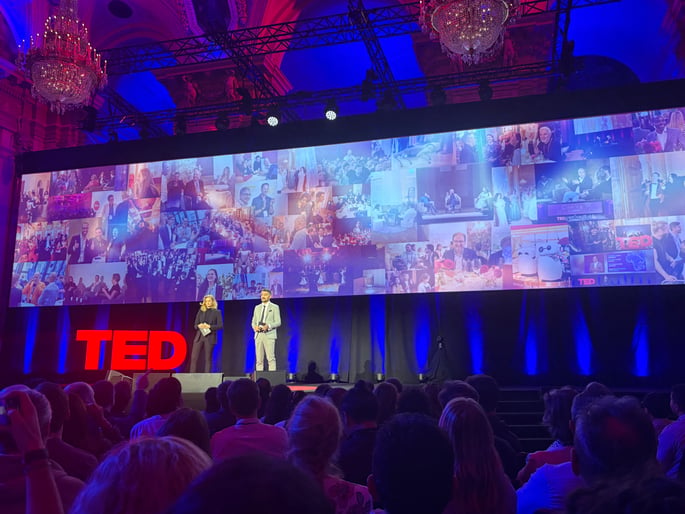
Beyond the hype
We are constantly bombarded with narratives about Artificial Intelligence, casting it as either a utopian savior or a dystopian threat. But the most important conversations about AI are happening somewhere in the middle, focusing less on futuristic technology and more on present-day humanity. Insights from the recent TEDAi Vienna conference reveal a stark choice: AI can be a tool for unprecedented human augmentation or a mechanism for mass de-skilling and societal division. The difference lies not in the code, but in our courage.
Takeaway 1: AI is not a tool, it's a choice between a ladder and a wall
AI's true nature: A ladder for the few or a wall for the many?
The most powerful metaphor for AI's societal impact is not one of robots or brains, but of simple structures: a ladder and a wall. For the wealthy and privileged, AI can be a ladder, offering access to better jobs, smarter healthcare, and increased competitiveness. For the poor and disconnected, however, that same technology can become an insurmountable wall, blocking opportunities and deepening existing inequalities.
This isn't an abstract risk; it's a present-day reality. With 2.6 billion people still without internet access, the "wall" is being built with every new technology that assumes universal connectivity. To be truly inclusive, technology cannot cost more than $25. This forces us to confront the central question of the AI era: How can we ensure we build ladders for everyone? It shifts the focus from what the technology can do to what it should do, demanding that we measure its success not by its processing power, but by its capacity for inclusion.
Takeaway 2: The goal isn't an assistant, it's a partner
Stop asking AI to do your job - ask it to make you think
A fundamental misunderstanding of AI's potential is to view it merely as a hyper-efficient assistant. This model casts AI as an automaton designed to perform known tasks faster. A far more transformative approach is to see AI as a thinking tool-a partner that helps you understand your work more deeply, improve its quality, and explore the unknown.
The choice we face is a critical one, and it defines the nature of our relationship with technology:
"Do you want a tool that thinks for you, or a tool that makes you think?"
This distinction is a game-changer. Viewing AI as a mere assistant risks creating a dependency that atrophies our own critical thinking. In contrast, embracing it as a thought partner forces us to become better question-askers and more precise thinkers, turning the technology into a catalyst for our own intellectual development. It’s the difference between automation that de-skills and augmentation that elevates.
Takeaway 3: To win with AI, you have to be willing to destroy your own business
The "Rip and Replace" revolution: Be your own disrupter
The case of the customer service platform Intercom provides a radical lesson in corporate strategy for the age of AI. Their guiding principle is a stark one: "Become the company that destroys you, before someone else does."
Instead of incrementally patching old systems with AI features, Intercom adopted a "Rip and Replace" philosophy. They chose to build entirely new systems from the ground up. However, this radicalism is paired with strategic pragmatism. The key is to start small: choose a battle you know AI can solve, win it, show its value, and then move on.
This strategy revealed a surprising truth: their customer service employees were not replaced. Instead, they were elevated to become "AI-dirigents"-conductors orchestrating AI systems-or "Customer Owners," making their roles more strategic and important. This courageous approach proves that the most successful AI transformations are about fundamentally rethinking your business with a human-in-the-center design.
Takeaway 4: The biggest threat isn't job loss, it's outsourcing our humanity
The philosophical trap: Are we outsourcing what it means to be human?
Beyond the practical concerns of jobs and business models lies a profound philosophical warning. We must not use AI to make critical decisions for people, because the outcome-be it joy, pain, or justice-means nothing to a machine. The true goal of "AI for good" should be to free up our time and cognitive load so that we can be more human, not less.
This leads to the most important question we must ask ourselves:
"Are we outsourcing being human to AI?"
This isn't just a philosophical abstraction; it has direct consequences. When we build "walls" instead of "ladders", or when we reduce employees to monitors of automated systems instead of elevating them to "Customer Owners", we are already engaging in this act of outsourcing. We are outsourcing empathy, judgment, and responsibility-the very things that define us.
Conclusion: The real superpower in the age of AI
The core message is clear: the AI revolution is a challenge of culture, leadership, and philosophy. When we focus only on the technology, we risk building walls of exclusion and outsourcing the very judgment that makes us human.
In this new era, past experience is less valuable than the ability to learn quickly-a skill that has become a genuine superpower. To cultivate it, leaders must create a culture of experimentation, starting with low-risk projects that aim for high ROI to build momentum, and being transparent about goals.
As we move forward, the ultimate task is not simply to build smarter machines, but to design them in service of a better humanity. We must constantly ask ourselves the final, critical question:
How do we design technology that helps us strengthen our interpersonal relationships and our own humanity?

Fredrik Paus
Les flere artikler fra Fredrik Paus. CEO og partner i Frontkom.
